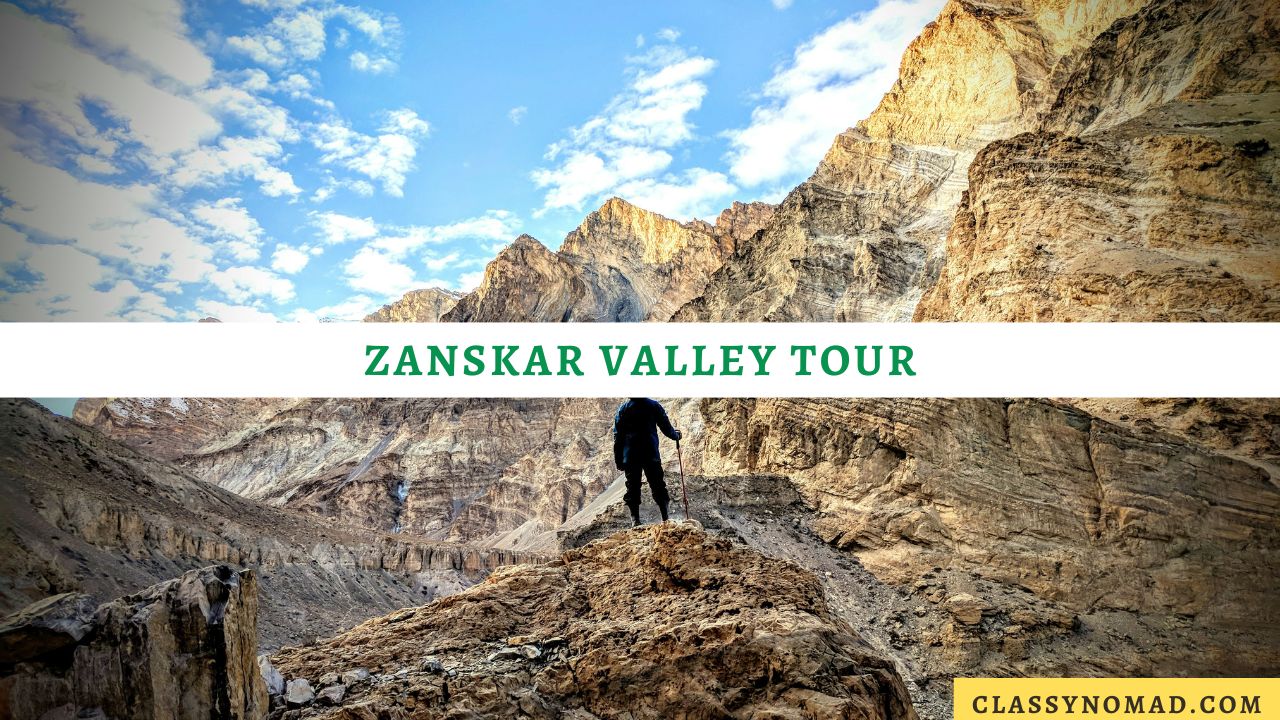Zanskar Valley tour offers one of India’s most authentic Himalayan experiences, combining challenging adventures with rich Buddhist culture. Zanskar Trip is possible only in the balmy weather of Summer (June to September).
Located in Ladakh’s remote corners, this high-altitude destination remains inaccessible in the winter season of the year due to heavy snowfall.
Zanskar provides rare opportunities to experience traditional Tibetan Buddhist culture along with challenging high-altitude treks.
It offers a complete digital detox and abundant stargazing under pristine skies.
Suggested – Mesmerizing Places to Visit in Uttarakhand
Key Attractions
- Chadar Trek: Walk on a frozen river (Jan-Feb only)
- River Rafting: Navigate thrilling rapids (June-Aug)
- Ancient Monasteries: Visit cliffside Phugtal and hilltop Karsha
- Pristine Landscapes: Discover untouched valleys and glacial lakes
Travel Essentials
- • Best visited June-September for accessible roads
- • Requires proper acclimatization (3,500m+ altitude)
- • Basic guesthouses only – no luxury accommodations
- • Limited connectivity (BSNL network works occasionally)
This destination suits adventurous travelers comfortable with basic facilities and unpredictable mountain conditions. Proper preparation ensures a safe and rewarding experience.
Here is a guide to planning a perfect and thrilling Zanskar with Cliffhangers India.
Zanskar Valley Trekking Routes
For trekkers seeking raw Himalayan adventures, Zanskar’s trails offer unmatched challenges and rewards. These Zanskar Valley trekking routes aren’t just walks – they’re journeys through living mountain culture.
1. Padum to Darcha – The Classic Challenge
This 8-10 day test takes you over the 5,091m Shingo La pass. Strong hikers are often humbled by its steep ascents and unpredictable weather. However, the reward? Lingshed Monastery appears like a mirage after days of wilderness.
Duration: 8-10 days
Difficulty: Challenging
Highlights: Cross Shingo La pass (5,091m), visit ancient Lingshed Monastery
Best Season: July-September
2. Lamayuru to Padum – A Photographer’s Dream
Spanning 10-12 days, this route’s crown jewel is Singge La pass. The remote villages along the way keep centuries-old traditions alive.
Duration: 10-12 days
Difficulty: Strenuous
Highlights: Traverse Singge La pass (5,091m), explore remote Zanskari villages
Best Season: June-September
3. Chadar Trek – Walking on Ice
Only attempted January-February, this 9-11 day trek on the frozen Zanskar River is unlike any other. The ice groans beneath your feet, and temperatures plunge to -35°C.
Duration: 9-11 days
Difficulty: Extreme
Highlights: Walk on frozen Zanskar River (-25°C to -35°C)
Season: January-February
What You Should Know
- All routes demand respect – altitude sickness is common
- Local guides aren’t optional; they’re lifesavers
- Weather changes hourly – pack for blizzards even in summer
- Permits must be arranged through registered operators like Cliffhangers India.
Frozen River Trek – Chadar Trek
The legendary Chadar Trek is Zanskar’s ultimate winter adventure – a journey across the frozen Zanskar River that transforms into an icy highway each January-February. This isn’t just a trek; it’s a survival test in one of Earth’s harshest environments.
Key Details
- When: Mid-January to late February (peak freezing conditions)
- Duration: 9-11 days from Leh to Padum and back
- Temperature: -25°C to -35°C (camera batteries die in minutes)
- Unique Feature: Follows ancient trade route still used by Zanskari people
Who Should Attempt It
- Experienced trekkers comfortable with extreme cold
- Those prepared for basic camping on ice
- Adventurers seeking ultimate bragging rights
How to Join
Book through registered operators like Cliffhangers India in Leh
Mandatory gear check includes:
- Special crampons for icy surfaces
- Expedition-grade sleeping bags (-40°C rating)
- Local guides essential – they read the ice like a map
The Frozen River Trek Zanskar demands resilience. The ice constantly shifts – one morning you might wake to find your previous day’s path gone. But witnessing this crystalline world of frozen waterfalls and towering canyon walls makes every shiver worthwhile.
Zanskar Valley Travel Guide
Planning a trip to this remote Himalayan valley requires careful preparation. Here’s what every traveler should know before embarking on their Zanskar journey:
Permits & Documentation
- Indian nationals need no special permits
- Foreign travelers require Protected Area Permit (PAP)
- Carry multiple photocopies of ID proofs
Best Time to Visit
- June to September: Road access via Pensi La
- January-February: Chadar Trek season
- Avoid monsoon (July-August) due to landslide risks
Accommodation & Food
- Basic guesthouses in Padum (₹800-1500/night)
- Homestays in villages (book through local guides)
- Limited vegetarian options – try thukpa and momos
Health & Safety
- Spend 2 days acclimatizing in Leh/Kargil
- Carry Diamox for altitude sickness
- Pack comprehensive first-aid kit
Transport Options
- Shared jeeps from Leh (₹2500-3000)
- Private 4×4 vehicles recommended
- No fuel stations beyond Rangdum – carry extra fuel.
Connectivity
- BSNL network works intermittently in Padum
- No ATM facilities – carry sufficient cash
This Zanskar Valley travel guide emphasizes preparation – the key to enjoying one of India’s last truly wild frontiers. Respect the altitude, pack wisely, and embrace the unpredictable – that’s where Zanskar’s magic lies.
Packing Tips for Zanskar Treks
Pack smart for Zanskar’s extremes:
- Clothing: Thermal base layers, fleece jacket, windproof outer shell, woolen socks, gloves, and a warm hat
- Footwear: Sturdy waterproof trekking boots + camp shoes
- Gear: Headlamp, sleeping bag (-15°C rating), trekking poles
- Health: Diamox, painkillers, ORS, blister kit, sunscreen (SPF 50+)
- Essentials: Reusable water bottle, power bank, cash (no ATMs)
Cultural Considerations & Responsible Travel
- Dress modestly (covered shoulders/knees) near monasteries.
- Always ask before photographing people or religious sites.
- Carry out all trash – no disposal facilities exist.
- Support local businesses by hiring Zanskari guides.
- Donate respectfully at monasteries (avoid handing cash directly to monks).

